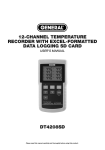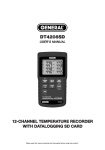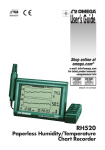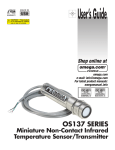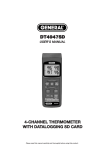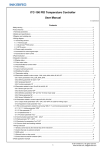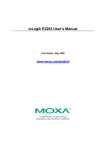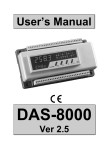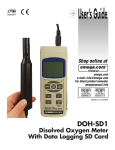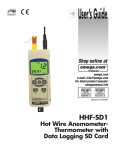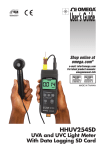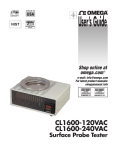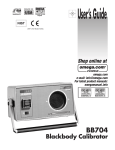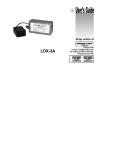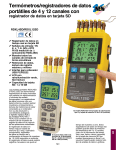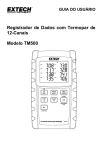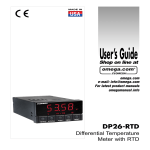Download Manual - OMEGA Engineering
Transcript
SM Extended Warranty Program User’s Guide Shop online at omega.com ® e-mail: [email protected] For latest product manuals: omegamanual.info MADE IN TAIWAN RDXL12SD 12-Channel Temperature Recorder with Excel-Formatted Data Logging SD Card OMEGAnet ® Online Service omega.com Internet e-mail [email protected] Servicing North America: U.S.A.: ISO 9001 Certified Canada: Omega Engineering, Inc., One Omega Drive, P.O. Box 4047 Stamford, CT 06907-0047 USA Toll-Free: 1-800-826-6342 Tel: (203) 359-1660 FAX: (203) 359-7700 e-mail: [email protected] 976 Bergar, Laval (Quebec), H7L 5A1 Canada Toll-Free: 1-800-826-6342 TEL: (514) 856-6928 FAX: (514) 856-6886 e-mail: [email protected] For immediate technical or application assistance: U.S.A. and Canada: Sales Service: 1-800-826-6342/1-800-TC-OMEGA® Customer Service: 1-800-622-2378/1-800-622-BEST® Engineering Service: 1-800-872-9436/1-800-USA-WHEN® Mexico Latin America TEL: 001 (203) 359-1660 e-mail: [email protected] China: 1698 Yi Shan Road, Unit 102, Min Hang District Shanghai, China 201103 P.R.C. Hotline: 800 819 0559/400 619 0559 e-mail: [email protected] Benelux: Toll-Free: 0800 099 3344 FAX: +31 20 643 46 43 Czech Republic: Frystatska 184, 733 01 Karviná, Czech Republic TEL: +420-59-6311899 FAX: +420-59-6311114 e-mail: [email protected] France: Toll-Free: 0805 466 342 FAX: 01 57 32 48 18 FAX: 001 (203) 359-7700 Servicing Asia: Servicing Europe: TEL: +31 20 347 21 21 e-mail: [email protected] TEL: 01 57 32 48 17 e-mail: [email protected] Germany/ Austria: Daimlerstrasse 26, D-75392 Deckenpfronn, Germany Toll-Free: 0800 8266342 FAX: +49 (0) 7056 9398-29 TEL: +49 (0) 7056 9398-0 e-mail: [email protected] United Kingdom: OMEGA Engineering Ltd. ISO 9001 Certified One Omega Drive, River Bend Technology Centre, Northbank Irlam, Manchester M44 5BD United Kingdom Toll-Free: 0800-488-488 TEL: +44 (0) 161 777-6611 FAX: +44 (0) 161 777-6622 e-mail: [email protected] It is the policy of OMEGA Engineering, Inc. to comply with all worldwide safety and EMC/EMI regulations that apply. OMEGA is constantly pursuing certification of its products to the European New Approach Directives. OMEGA will add the CE mark to every appropriate device upon certification. The information contained in this document is believed to be correct, but OMEGA accepts no liability for any errors it contains, and reserves the right to alter specifications without notice. WARNING: These products are not designed for use in, and should not be used for, human applications. 12-CHANNEL TEMPERATURE RECORDER WITH EXCEL-FORMATTED DATA LOGGING SD CARD USER’S MANUAL RDXL12SD Please read this manual carefully and thoroughly before using this product. TABLE OF CONTENTS Introduction . . . . . . . . . . . . . . . . . . . . . . . . . . . . . . . . . 3 Key Features . . . . . . . . . . . . . . . . . . . . . . . . . . . . . . . . 4 What’s in the Case. . . . . . . . . . . . . . . . . . . . . . . . . . . . 4 Product Overview . . . . . . . . . . . . . . . . . . . . . . . . . . . . 5 Setup Instructions . . . . . . . . . . . . . . . . . . . . . . . . . 6 – 8 Adjusting Thermcouple Offsets. . . . . . . . . . . . . . . . . . 8 Operating Instructions. . . . . . . . . . . . . . . . . . . . . 9 – 12 Normal Operation . . . . . . . . . . . . . . . . . . . . . . . . 9 Holding and Storing Measurements. . . . . . . . . 10 Automatic vs. Manual Data Logging . . . . 10 – 11 Transferring Data from the SD Card to a Computer . . . . . . . . . . . . . . . . . . . . . . . . . . 12 Specifications . . . . . . . . . . . . . . . . . . . . . . . . . . . . . . 13 Maintenance & Troubleshooting Tips . . . . . . . . . . . . 14 2 INTRODUCTION Thank you for purchasing Omega® RDXL12SD 12-Channel Temperature Recorder with Excel-formatted Data Logging SD Card. Please read this user’s manual carefully and thoroughly before using the instrument. The RDXL12SD is a general-purpose handheld instrument that can measure up to 12 channels of temperature with 0.4% accuracy using any of six different types of thermocouple. Up to eight channels can be displayed at a time. The instrument also can be configured to automatically record up to 12 channels during the same period every day— a function called loop data recording. Although thermocouples are not as accurate as other types of thermometers, they more than make up for this shortcoming with an extended measurement range. For example, the RDXL12SD can measure and read out temperatures from -148º to 2372ºF (-100º to 1300ºC) using “K” type thermocouples, and temperatures from -148º to 2102ºF (-100º to 1100°C) using “J” type thermocouples. “R” and “S” type thermocouples have an even higher upper limit. The two “K” type thermocouples included with the instrument have a measurement range of -50° to 500°F (-45° to 260°F). These very wide ranges, plus a fast response time and a low price tag, suit thermocouple thermometers for a variety of commercial and industrial tasks requiring measurement of very high and low temperatures. Examples include applications in the food and chemical processing industries, HVAC (heating, ventilation and air-conditioning), power generation, and paper production. Because it is microprocessor-based, the RDXL12SD can make full use of the portability, reliability and large storage capacities that SD memory cards offer. Measurements can be made automatically at any sampling rate between one second and one hour. After timestamping and storing the measurements on an SD card plugged into the instrument (a process called data logging), the user can remove the card and plug it into to a laptop or desktop computer either directly or through an SD card reader. The data logs are stored on the card as files with the .xls extension, which can be opened by Microsoft’s Excel application. The RDXL12SD has a backlit 3.9 in. diagonal display and is powered by eight “AA” batteries or an optional 9-VDC AC adapter. 3 KEY FEATURES • Twelve independent temperature measurement channels • Displays up to eight channels at a time; one push of a button switches to Channels 9 through 12 • Works with and automatically temperature-compensates for six popular thermocouple types: K, J, T, E, S and R • Combining thermocouple types extends potential measurement range to -148º to 3092ºF (-100º to 1700ºC) • Can automatically log up to 12 channels of data every day during same period (loop data recording) • Big (3.9 in. diagonal) front-panel green backlit LCD is easy to read • Displays maximum and minimum readings and holds any reading • Automatically logs measurements at sampling time settable from one second to one hour • Also supports manual data logging and changing of SD card storage location • Outputs Excel-compatible data logs • Accepts SD memory cards of up to 16 GB capacity • Auto power off function that can be disabled to enable long-term data logging • Powered by eight “AA” batteries or optional 9V AC/DC adapter WHAT’S IN THE CASE The RDXL12SD comes fully assembled in a carrying case along with a 2 GB SD memory card, two general-purpose “K” type thermocouples and this user’s manual. 4 PRODUCT OVERVIEW Figure 1 shows all of the controls and indicators on the front, right side, back and top of the RDXL12SD. Familiarize yourself with the positions and functions of these controls, indicators and connectors before moving on to the Setup Instructions. TOP FRONT RIGHT SIDE BACK 1-14 1-17 Fig. 1. The RDXL12SD’s controls and indicators and other physical features 1-10 SD CARD socket 1-1 LCD 1-11 RS232 output jack 1-2 POWER/ESC button 1-12 RESET button 1-3 HOLD/NEXT button 1-13 DC9V jack 1-4 REC/ENTER button 1-14 Housing penetration and rubber plug 1-5 TYPE button (reserved for future use) 1-6 PAGE button 1-15 Flip-up stand 1-7 LOGGER button 1-16 Battery compartment cover 1-8 SET button 1-17 Battery compartment cover screws 1-9 Thermocouple jacks T1 through T12 5 SETUP INSTRUCTIONS 1. Choose the power source. Before using the RDXL12SD, make sure it is powered by fresh batteries or an optional 9VDC AC adapter plugged into the DC9V jack on its right side (callout 1-13). To remove the battery compartment cover (callout 1-16), remove the two screws (callout 1-17) holding it in place. Then install eight “AA” batteries in the correct orientation, using the polarity marks on the inside of the compartment as a guide. Replace the cover and secure it by tightening the two screws. 2. Install an SD card. To prepare for setup, also install the supplied 2 GB SD card or another card of 1 GB to 16 GB capacity in the socket on the right side of the instrument (callout 1-10). When installing the card, make sure its gold contacts are facing the back of the instrument and push the card into the socket until you hear a click. To remove the card, push it in until you hear a click and the card pops out. Now power on the instrument by pressing the POWER/ESC button (callout 1-2) to generate a short beep. (To power off the RDXL12SD, press the POWER/ESC button and hold it until the instrument responds with a long beep.) When the temperature recorder powers on, a series of transient startup screens will briefly appear. Once the display has stabilized, perform the following eight setup steps in the order presented. 3. Set the date and time. Press the SET button (callout 1-8) and hold it for at least five seconds, until the word “dAtE” appears flashing on the top line of the left column of the display. Quickly (within three seconds), press the REC/ENTER button. Set the current year by pressing the TYPE or PAGE button repeatedly until the correct value appears flashing on the top line of the left column. Quickly (within three seconds), press the REC/ENTER button to store the setting. The next screen that appears will show the value “01” flashing on the second line. Use the TYPE or PAGE button to navigate to the current month and press the REC/ENTER button to store the setting. When the value “01” begins flashing on the third line, again use the TYPE or PAGE button to navigate to the current day and press the REC/ENTER button to store the setting. (If you press buttons too slowly in setup mode, the screen will revert to the normal, realtime measurement display. To return to the first step in the setup sequence, press and hold the SET button again. To move ahead to the next field in the sequence or to the next parameter, press the HOLD/NEXT button.) Once you have set the date, the display will prompt you to set the hour, minute and second of the current time, in 24-hour format. The three values appear on the top three lines in the right column of the Date/Time Setting screen. To set each value, again use the TYPE or PAGE buttons to navigate to the correct values, followed by the REC/ENTER button to store the setting. 6 4. Set the start and stop times for “loop data recording”—logging up to 12 channels of temperature information during the same period (for example, 14:15 to 15:30) every day. Once you have set the date and time, the display will show the flashing term “LooP” in the second row of the left column. Press the REC/ENTER button and then—with “00” flashing under the term "StAR" in the left column— use the TYPE and PAGE buttons to set the first of the four values that define the loop: the starting hour. Press the REC/ENTER button to store your selection. Then use the TYPE and PAGE buttons with “00” flashing below the term “t” in the right column to set the loop’s starting minute. Again press the REC/ENTER button to store your selection. Repeat this sequence twice more to set and store the loop’s ending hour and minutes values. Once you have entered the fourth value—the loop’s ending minute— the following screen will appear: To enable recording of data during the specified loop duration, press either the TYPE or PAGE button to change the “no” to a “yES” and then press the REC/ENTER button to store the selection. To disable recording, press the REC/ENTER button without changing the “no” to a “yES”. 5. Choose a decimal point or comma to represent the decimal division between integers and fractions (for example, American-style 20.88 vs. European-style 20,88). Once you have set the start and stop times of loop data recording and enabled or disabled the function, the display will show the term “dEC” in the third row of the left column. Press the REC/ENTER button. This will cause the term "dEC" to appear in the lower right corner below the term “USA”. Use the TYPE or PAGE button to make “USA” or “Euro” (as desired) appear above “dEC” and then press the REC/ENTER button to store the selection as the default. 6. Enable or disable auto power off (APO). Once the format of decimal point divisions has been set and stored, the display will show the term “PoFF” in the bottom row of the left column. Press the REC/ENTER button and then press the TYPE or PAGE button until the desired automatic power off management scheme (“yES” for enable; “no” for disable) is displayed. Press the REC/ENTER button to store the selection. If enabled, the APO function shuts off the RDXL12SD if no front-panel buttons are pressed during any ten-minute period. 7. Enable or disable the beeper. Once the APO function has been enabled or disabled, the display will show the term “bEEP” in the top row of the right column. Press the REC/ENTER button and then press the TYPE or PAGE button until the desired setting (“yES” or “no”) is displayed. Finally, press the REC/ENTER button to store the selection as the default. 8. Select the temperature unit. Once the beeper has been enabled or disabled, the display will show the term “t-CF”in the second row of the right column. Press the REC/ENTER button and then press the TYPE or PAGE button until the unit you prefer (“F” for Fahrenheit, “C” for Celsius”) is displayed. Then press the REC/ENTER button to store the selection as the default. 7 9. Set the data logging sampling time. Once the default temperature unit has been selected and stored, the display will show the term “SP-t” in the third row of the right column. Press the REC/ENTER button and then press the TYPE or PAGE button to decrease or increase the value until the desired sampling time appears above “SP-t”. The options are 0, 1, 2, 5, 10, 30, 60, 120, 300, 600, 1800 and 3600 seconds (0 seconds to 1 hour). Then press the REC/ENTER button to store the selection as the default. 10. Format the SD card. Once the sampling time has been set and stored, the term “Sd-F” will appear in the bottom row of the right column. Press the REC/ENTER button. Pressing the REC/ENTER button will cause the word “no” to appear over the term “Sd-F”. Press the TYPE or PAGE button to toggle between "no" and "yES". Choose “yES” whenever a new SD card is being used, or when a used card is being repurposed (from use with another SD card instrument or a camera, for example) and all data on it is to be erased. Choose “no” to preserve any data on a card previously used with this instrument. Press the REC/ENTER button to make a selection. If you choose “yES”, after you press the REC/ENTER button the instrument will prompt you to confirm that decision by displaying the term “Ent” below “yES” and sounding three beeps (if the beeper is enabled). To confirm that you want to begin the erasure/formatting procedure, press the REC/ENTER button. “Ent” will then flash several times and the instrument will sound another three beeps to confirm that the SD card has been erased and formatted. Once the SD card has been formatted (or not), the display will return to flashing the first of the eight steps in the setup sequence—setting the current date and time. To re-enter the setup sequence in order to change one or more settings, press the REC/ENTER button. If you are satisfied with the existing settings, press the POWER/ESC button to exit setup mode and enter normal operating mode. ADJUSTING THERMOCOUPLE OFFSETS To maximize the accuracy of measurements, Omega strongly recommends that you compensate for (offset) the small measurement error peculiar to each thermocouple used with the instrument. To adjust the offset of a thermocouple, press the TYPE button until its type appears on the top line of the display. Then plug the thermocouple into the T1 jack on the top of the thermometer. Press the LOGGER button (which has the term “Offset” stenciled above it), hold it for at least three seconds, and then release the button. The screen shown at right will appear: Next, use the TYPE or PAGE button to adjust the value under “oFS” to match the value under “SEt”. Then press the REC/ENTER button to store the offset adjustment and return the instrument to measurement mode. Repeat the procedure for each thermocouple to be used. 8 OPERATING INSTRUCTIONS NORMAL OPERATION 1. To prepare to make measurements, power on the RDXL12SD and make sure an SD card is firmly seated in the socket on the bottom of the instrument. By default, the RDXL12SD uses Celsius units for temperature measurements. If you wish to make Fahrenheit units the default, press the SET button to enter setup mode. Using the HOLD/NEXT button, skip ahead to Step 8 of the Setup Instructions and perform it. 2. To use “K” type thermocouples to measure up to 12 channels of temperature, plug one to 12 of them (two are supplied, others are available for purchase from General) into the jacks (callout 1-9 of Fig. 1) on the top of the temperature recorder. Make sure jack T1 is occupied. Because “K” is the instrument’s default thermocouple type, plugging in up to eight “K” type thermocouples will instantly produce up to eight display readings. Any of the eight channels that are not used will show the overrange reading “- - - - -”. To show the other four of the 12 channels, press the PAGE button once. To return the display to Channels T1 through T8, press the PAGE button again. 3. To use “J”, “T”, “E”, “R” or “S” type thermocouples to measure up to 12 channels of temperature, first press the TYPE button as many times as necessary until the letter of the thermocouple type you are using appears on the top line of the display. Then plug one to 12 of the optional accessories into the jacks on the top of the thermometer. As with “K” type thermocouples, display readings are instantaneous. Use the PAGE button to toggle between displaying Channels T1 through T8, or Channels 9 through 12, as with “K” type thermocouples. Whenever the thermometer is in measurement mode, you can turn off the backlight (which is on by default) by briefly pressing (but not holding) the POWER/ESC button, which has a backlight icon stenciled above it. To reactivate the backlight, briefly press the button again. Whenever the instrument is in measurement mode, you also can check the current date and time by briefly pressing the SET button (which has the words “Time check” stenciled below it). Doing so causes the three settings year, month + day, and hour + minutes to appear briefly and in that order at the lower left of the display. 9 HOLDING AND STORING MEASUREMENTS 1. To hold a measured value, press the HOLD/NEXT button during the measurement. Doing so will cause the word “HOLD” to appear at the top of the display. Pressing the HOLD/NEXT button again releases the hold. 2. To record and recall readings, press the REC/ENTER button while making measurements. This will make the term “REC” appear at the top of the display. Pressing the REC/ENTER button again, briefly, will make the term “MAX” appear to the right of “REC” and switch the display to the maximum value stored in memory during the current recording session. Pressing the REC/ENTER button again, briefly, will make the term “MIN” appear to the right of “REC” and switch the display to the minimum value stored during the current session. 3. To exit recording mode, press the REC/ENTER button and hold it for at least three seconds, until the term “REC” disappears from the top line of the display. The display will then revert to showing real-time readings. AUTOMATIC VS. MANUAL DATA LOGGING The RDXL12SD can automatically log data at a user-selected sampling period from 1 second to 3,600 seconds (one hour). To view the sampling time that the instrument has been set up to use, press the LOGGER button (which has the words “Sampling time check” stenciled below it) once. The lower left corner of the display will briefly show the term “SP-t”, followed by the currently programmed sampling time in seconds. To change the sampling time, enter setup mode and perform Step 9 of the Setup Instructions. Before entering data logging mode, remember to disable the meter’s Auto Power Off function. To do so, enter Setup mode (as explained in the Setup Instructions on p. 6) and select “no” during Step 6. Also be sure that the meter either is running on fresh batteries or is being powered by AC through a 9VDC adapter. 1. To start automatic data logging, press the REC/ENTER button once. The top line of the display will then show the term “REC”. Pressing the LOGGER button at this point will make “REC” flash and add the flashing term “DATALOGGER” at the bottom of the display. This indicates that the instrument is sampling measurements at the programmed rate and storing the readings and their time stamps in memory. 2. To pause automatic data logging, press the LOGGER button once; this will make the flashing term “LOGGER” disappear from the bottom of the display and change the term “REC” from flashing to constant. Pressing the LOGGER button again resumes automatic data logging. 10 3. To end automatic data logging, first press the LOGGER button to pause data logging. Then press the REC/ENTER button and hold it for at least two seconds. This will cause “REC” to disappear. 4. To log data manually, set the sampling time to zero using Step 9 of the Setup Instructions on p. 8. Then press the REC/ENTER button once. The display will show the term “REC” on the top line and a flashing letter “P” and a number from 1 to 99 on the bottom line. The number indicates the position on the SD card that will be used to store manually logged data. In manual data logging mode, this position can be changed. 5. To change the storage location of manually logged data, press the TYPE button once; this will cause the “P” to disappear from the left side of the display and the value on its line to begin flashing. Once the flashing begins, you can use the TYPE and PAGE buttons to change the flashing value to any number between 1 and 99. Once you have chosen the storage location, press the REC/ENTER button to save the setting. This will cause the value to stop flashing and the “P” to return. 6. To end manual data logging, press the REC/ENTER button and hold it for at least three seconds. This action will cause “REC” to disappear from the top line of the display. 7. To execute the loop data recording function (if the function was enabled during setup) press the REC/ENTER button while the instrument is in measurement mode. Doing so will make the term “REC” appear at the top of the display and prepare the instrument to log data during the specified daily period. 8. To pause loop data recording during the specified period, press the LOGGER button once. This will make the term “REC” stop flashing. Pressing the LOGGER button again will resume loop data recording. 9. To end loop data recording, press the REC/ENTER button and hold it for at least three seconds. This will cause “REC” to disappear from the display and end loop data recording. 11 TRANSFERRING DATA FROM THE SD CARD TO A COMPUTER After automatic or manual data logging of measurements, or loop data recording, remove the SD card from the instrument and plug it into your computer either directly (if it has an SD card slot) or through an SD card reader. Because the files containing time-stamped data logs have the file extension .xls, they open in Microsoft’s Excel application. Figures 2 and 3 show two kinds of Excel presentations: a data-only screen and a graphics-only screen. Fig. 2. Typical Excel data-only screen 12 Fig. 3. Typical Excel graphics-only screen SPECIFICATIONS Display type LCD with green backlight Display size 3.23 x 2.40 in. (82 x 61mm) Parameter measured Temperature (in °F or °C) Measurement range With “K” type thermocouples: -148° to 2372°F (-100° to 1300°C); two included TPK500 probes have measurement range of -50° to 500°F (-45° to 260°C) With “J” type: -148° to 2102°F (-100° to 1150°C) With “T” type: -148° to 752°F (-100° to 400°C) With “E” type: -148° to 1652°F (-100° to 900°C) With “R” type: 32° to 3092°F (0° to 1700°C) With “S” type: 32° to 2732°F (0° to 1500°C) Measurement accuracy With “K”, “J”, “T” and “E” type thermocouples: ± (0.4% of reading + 2.0ºF max) With “R” and “S” types: ±(0.5% of reading + 5°F) Measurement resolution With “K”, “J”, “T” and “E” type thermocouples: 0.1° (F or C) below 1000ºF, 1° (F or C) above 1000°F With “R” and “S” types: 1° (F or C) Sampling time options 0, 1, 2, 5, 10, 30, 60, 120, 300, 600, 1800 or 3600 seconds Settable parameters Date, time, decimal point or comma decimal division, auto power off, beep sound, loop data recording enable/disable and start/stop times, temperature unit, sampling time, thermocouple type and offset Storable readings Maximum, minimum SD card capacity 1 GB to 16 GB Operating temperature 32° to 122°F (0° to 50°C) Operating relative humidity 0 to 85% Power source 8 “AA” batteries or optional 9-VDC AC adapter Power consumption 7.5 mADC (normal operation, with backlight off and SD card not saving data); 25 mADC with backlight off and card saving data; 36 mADC with backlight on and card saving data Dimensions 8.86 x 4.92 x 2.52 in. (225 x 125 x 64mm) Weight 1.84 lb. (827g) 13 MAINTENANCE & TROUBLESHOOTING TIPS Keep your probes and thermocouples clean. When the icon appears in the upper left corner of the display, it’s time to replace the eight “AA” batteries that power the instrument (although measurements will remain valid for several hours after the low-battery indicator first appears). Replacing the batteries requires removing the two screws that hold the battery compartment cover in place, as explained in Step 1 of the Setup Instructions on p. 6. After inserting fresh batteries in the correct orientation, replace the cover and tighten the screws to secure it. If the meter “freezes” (like a computer) and buttons become unresponsive, try resetting the instrument by pushing the RESET button on its right side (callout 1-12 of Fig. 1) with the end of a paper clip. Remove the batteries when storing the instrument for an extended period of time. Do not drop or disassemble the instrument or immerse it in water. 14 NOTES: 15 NOTES: 16 WARRANTY/DISCLAIMER OMEGA ENGINEERING, INC. warrants this unit to be free of defects in materials and workmanship for a period of 13 months from date of purchase. OMEGA’s WARRANTY adds an additional one (1) month grace period to the normal one (1) year product warranty to cover handling and shipping time. This ensures that OMEGA’s customers receive maximum coverage on each product. If the unit malfunctions, it must be returned to the factory for evaluation. OMEGA’s Customer Service Department will issue an Authorized Return (AR) number immediately upon phone or written request. Upon examination by OMEGA, if the unit is found to be defective, it will be repaired or replaced at no charge. OMEGA’s WARRANTY does not apply to defects resulting from any action of the purchaser, including but not limited to mishandling, improper interfacing, operation outside of design limits, improper repair, or unauthorized modification. This WARRANTY is VOID if the unit shows evidence of having been tampered with or shows evidence of having been damaged as a result of excessive corrosion; or current, heat, moisture or vibration; improper specification; misapplication; misuse or other operating conditions outside of OMEGA’s control. Components in which wear is not warranted, include but are not limited to contact points, fuses, and triacs. OMEGA is pleased to offer suggestions on the use of its various products. However, OMEGA neither assumes responsibility for any omissions or errors nor assumes liability for any damages that result from the use of its products in accordance with information provided by OMEGA, either verbal or written. OMEGA warrants only that the parts manufactured by the company will be as specified and free of defects. OMEGA MAKES NO OTHER WARRANTIES OR REPRESENTATIONS OF ANY KIND WHATSOEVER, EXPRESSED OR IMPLIED, EXCEPT THAT OF TITLE, AND ALL IMPLIED WARRANTIES INCLUDING ANY WARRANTY OF MERCHANTABILITY AND FITNESS FOR A PARTICULAR PURPOSE ARE HEREBY DISCLAIMED. LIMITATION OF LIABILITY: The remedies of purchaser set forth herein are exclusive, and the total liability of OMEGA with respect to this order, whether based on contract, warranty, negligence, indemnification, strict liability or otherwise, shall not exceed the purchase price of the component upon which liability is based. In no event shall OMEGA be liable for consequential, incidental or special damages. CONDITIONS: Equipment sold by OMEGA is not intended to be used, nor shall it be used: (1) as a “Basic Component” under 10 CFR 21 (NRC), used in or with any nuclear installation or activity; or (2) in medical applications or used on humans. Should any Product(s) be used in or with any nuclear installation or activity, medical application, used on humans, or misused in any way, OMEGA assumes no responsibility as set forth in our basic WARRANTY / DISCLAIMER language, and, additionally, purchaser will indemnify OMEGA and hold OMEGA harmless from any liability or damage whatsoever arising out of the use of the Product(s) in such a manner. RETURN REQUESTS/INQUIRIES Direct all warranty and repair requests/inquiries to the OMEGA Customer Service Department. BEFORE RETURNING ANY PRODUCT(S) TO OMEGA, PURCHASER MUST OBTAIN AN AUTHORIZED RETURN (AR) NUMBER FROM OMEGA’S CUSTOMER SERVICE DEPARTMENT (IN ORDER TO AVOID PROCESSING DELAYS). The assigned AR number should then be marked on the outside of the return package and on any correspondence. The purchaser is responsible for shipping charges, freight, insurance and proper packaging to prevent breakage in transit. FOR WARRANTY RETURNS, please have the following information available BEFORE contacting OMEGA: 1. Purchase Order number under which the product was PURCHASED, 2. Model and serial number of the product under warranty, and 3. Repair instructions and/or specific problems relative to the product. FOR NON-WARRANTY REPAIRS, consult OMEGA for current repair charges. Have the following information available BEFORE contacting OMEGA: 1. Purchase Order number to cover the COST of the repair, 2. Model and serial number of the product, and 3. Repair instructions and/or specific problems relative to the product. OMEGA’s policy is to make running changes, not model changes, whenever an improvement is possible. This affords our customers the latest in technology and engineering. OMEGA is a registered trademark of OMEGA ENGINEERING, INC. © Copyright 2013 OMEGA ENGINEERING, INC. All rights reserved. This document may not be copied, photocopied, reproduced, translated, or reduced to any electronic medium or machine-readable form, in whole or in part, without the prior written consent of OMEGA ENGINEERING, INC. Where Do I Find Everything I Need for Process Measurement and Control? OMEGA…Of Course! Shop online at omega.com SM TEMPERATURE 䡺 ⻬ 䡺 ⻬ 䡺 ⻬ 䡺 ⻬ 䡺 ⻬ Thermocouple, RTD & Thermistor Probes, Connectors, Panels & Assemblies Wire: Thermocouple, RTD & Thermistor Calibrators & Ice Point References Recorders, Controllers & Process Monitors Infrared Pyrometers PRESSURE, STRAIN AND FORCE 䡺 ⻬ 䡺 ⻬ 䡺 ⻬ 䡺 ⻬ Transducers & Strain Gages Load Cells & Pressure Gages Displacement Transducers Instrumentation & Accessories FLOW/LEVEL 䡺 ⻬ 䡺 ⻬ 䡺 ⻬ 䡺 ⻬ Rotameters, Gas Mass Flowmeters & Flow Computers Air Velocity Indicators Turbine/Paddlewheel Systems Totalizers & Batch Controllers pH/CONDUCTIVITY 䡺 ⻬ 䡺 ⻬ 䡺 ⻬ 䡺 ⻬ pH Electrodes, Testers & Accessories Benchtop/Laboratory Meters Controllers, Calibrators, Simulators & Pumps Industrial pH & Conductivity Equipment DATA ACQUISITION 䡺 ⻬ 䡺 ⻬ 䡺 ⻬ 䡺 ⻬ 䡺 ⻬ Data Acquisition & Engineering Software Communications-Based Acquisition Systems Plug-in Cards for Apple, IBM & Compatibles Data Logging Systems Recorders, Printers & Plotters HEATERS 䡺 ⻬ 䡺 ⻬ 䡺 ⻬ 䡺 ⻬ 䡺 ⻬ Heating Cable Cartridge & Strip Heaters Immersion & Band Heaters Flexible Heaters Laboratory Heaters ENVIRONMENTAL MONITORING AND CONTROL 䡺 ⻬ 䡺 ⻬ 䡺 ⻬ 䡺 ⻬ 䡺 ⻬ 䡺 ⻬ Metering & Control Instrumentation Refractometers Pumps & Tubing Air, Soil & Water Monitors Industrial Water & Wastewater Treatment pH, Conductivity & Dissolved Oxygen Instruments M4995/0413




















